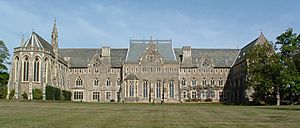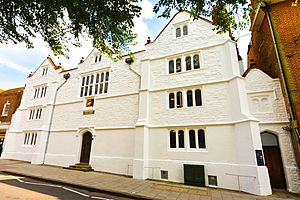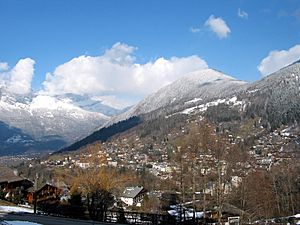Gunby Hadath facts for kids
Quick facts for kids
John Edward Gunby Hadath
|
|
|---|---|
| Born | 30 April 1871 Owersby, Lincolnshire, England
|
| Died | 17 January 1954 (aged 82) |
| Nationality | English |
| Other names | Gunby Hadath, Florence Gunby Hadath, John Mowbray, Felix O'Grady, James Duncan, Shepherd/Shepperd Pearson |
| Occupation | Schoolmaster, company promoter, journalist, song-writer, lawyer, and author |
| Years active | 1892 – 1954 |
| Known for | English Boarding School Stories |
|
Notable work
|
Sparrow in search of expulsion |
John Edward Gunby Hadath (born April 30, 1871 – died January 17, 1954) was an English writer, teacher, lawyer, and songwriter. He is most famous for writing over 70 books, mostly for young people, about life in English boarding schools. He also used other names for his books, like John Mowbray.
Contents
Early Life and Education
John Edward Gunby Hadath was born in Owersby, Lincolnshire, England, on April 30, 1871. He was the only son of Reverend Edward Evans Hadath. John had three older sisters. His father passed away when John was only two years old.
After attending a small local school, he went to the Clergy Orphan School in Canterbury. He was a very good athlete there, just like the heroes in his own stories. He was even the Captain of his school's sports teams.
In October 1889, John started studying at Cambridge University, at Peterhouse College. He continued to play sports, earning special awards for rugby, soccer, and cricket. He finished his degree in 1892 and began his career as a teacher.
Starting His Career
After leaving Cambridge, Hadath first taught at Montpellier School in Paignton. This was a private school. By 1894, he was the Second Master, meaning he was the second most important teacher after the Head Master. He also tutored students privately, perhaps to earn more money. It is not clear how long he stayed at this school.
New Paths and Interests
In January 1896, Hadath earned his Master of Arts degree. He became the Senior Classics Master at Guildford Grammar School. He continued to enjoy playing cricket.
In 1898, Hadath married Florence Annie Webber. They never had any children. Florence was very helpful because she could read his difficult handwriting and would type his stories for him.
By 1900, the Hadaths lived in Cricklewood, North London, which remained his home until he passed away. He also had a holiday home in Saint-Gervais-les-Bains in the French Alps, near the famous Mont Blanc mountain. He was even made an honorary citizen of the town in 1932.
Both John and Florence were very sporty. John played rugby, and Florence was a keen golfer.
By 1902, Hadath was earning a good income from writing songs, with over 100 songs published. He also worked for several companies, helping to manage them. He became a lawyer in 1908.
World War I Service
During the First World War, Hadath joined the 6th Battalion of the Middlesex Volunteer Regiment. This was a reserve group that stayed in England. He became a Captain in 1917. He left the army in 1918 due to health reasons.
Later Life and Writing
After the war, Hadath continued to write many books. He also coached students who were studying to become lawyers. He was involved with a fund that helped musicians and writers. He was also made a Fellow of the Royal Society of the Arts.
John Edward Gunby Hadath passed away in a London hospital on January 17, 1954. His wife, Florence, lived for another six years.
Many people praised Hadath's writing:
- He was known for his "authentic and true-to-life school stories."
- His books were seen as both educational and entertaining for young people.
- His stories often included sports, humor, and themes of loyalty.
- Reviewers said he understood the "atmosphere of the public school" and that "boys know it and revel in it."
However, not everyone agreed. Some librarians in New Zealand, for example, thought his books were not as good as others.
Hadath himself knew that books for young people were not always taken as seriously as adult books. He once said that writing for young people was difficult because "youth is an exceedingly critical audience."
By the time he died, the weekly magazines for boys, which often published his stories first, were becoming less popular. This meant that the type of school stories he wrote were also less common.
His Writing Style
Hadath's first published story for young people, a school story, appeared in The Captain in 1909. It featured a character named "Foozle," who appeared in many of his later stories.
He wrote for other popular boys' magazines like Chums, The Modern Boy, and The Boy's Own Paper. His stories that appeared in these magazines were almost always later published as full books.
Major Works
Here is a list of some of the full-length books written by Gunby Hadath. This list does not include his shorter stories or contributions to other collections.
| No | Year | Title | Illustrator | Publisher | Notes |
|---|---|---|---|---|---|
| 1 | 1913 | The Feats of Foozle | W. F. Thomas, T. M. R. Whitwell | London, Adam & Charles Black | |
| 2 | 1913 | Schoolboy grit: a public school story | A. Twiddle | London, James Nisbet & Co | |
| 3 | 1913 | Paying the price!: a public school story | E. Prater | London, S.W. Partridge | |
| 4 | 1914 | Never say die!: a public school story | London, S.W. Patridge | ||
| 5 | 1914 | The last of his line: a public school story | London, S.W. Partridge | ||
| 6 | 1915 | Sheepy Wilson: a public school story | London, James Nisbet | ||
| 7 | 1915 | The outlaws of St Martyn's, or, The school on the downs | London, S.W. Partridge | ||
| 8 | 1916 | Fall In! A public school story | London, S.W. Partridge | ||
| 9 | 1922 | Won by a try. A story, etc | Frank Gillett | London, Cassell & Co | |
| 10 | 1923 | The New House at Oldborough. A public school story | London, Hodder & Stoughton | A reviewer said this book "gets the boys’ noses right into it at the first page." | |
| 11 | 1924 | Against the Clock. A public school story | London, Hodder & Stoughton | ||
| 12 | 1924 | His Highness. A public school story | London, T. Nelson & Sons | ||
| 13 | 1924 | Pulling his weight: a public school story | London, Hodder & Stoughton | ||
| 14 | 1924 | Sparrow in Search of Expulsion, etc | London, Hodder & Stoughton | ||
| 15 | 1924 | The way of the Weasel : a public school story | London, S.W. Partridge | Published under the name John Mowbray. It's about a small boy who solves a mystery at school. | |
| 16 | 1925 | The Fattest Head in the Fifth, etc | London, Hodder & Stoughton | ||
| 17 | 1925 | Something like a hero | Henry Matthew Brock | London, Cassell & Co | |
| 18 | 1925 | Barkworth's Last Year. A school story | London, Cassell & Co | Published under the name John Mowbray. A boy is wrongly accused but clears his name. | |
| 19 | 1926 | Go-Bang Garry. A public school story | London, Hodder & Stoughton | ||
| 20 | 1926 | The secret of the code: being the truth of certain recent astonishing happenings at St. Quentin's School, Tidegate, and on the coast by Ottersfoot and Oldport | London, Hodder & Stoughton | ||
| 21 | 1926 | The Black Sheep of the School | London, Cassell & Co | ||
| 22 | 1927 | Feversham's fag | London, Cassell & Co | ||
| 23 | 1928 | Carey of Cobhouse, etc | London, Humphrey Milford | ||
| 24 | 1928 | Sparrow gets going: being the unvarnished truth concerning the notable efforts of Thomas Whitcombe Shirley Sparrow ... to become a great man of business and, perhaps, Lord Mayor of London | London, Hodder & Stoughton | This book collects many short stories about the character Sparrow. | |
| 25 | 1928 | The lost legion: a story of Wallcaster School | London, Hodder & Stoughton | ||
| 26 | 1928 | Wonder Island, etc | London, Cassell & Co | ||
| 27 | 1928 | Dismal Jimmy of the fourth | Henry Matthew Brock | London, Cassell & Co | |
| 28 | 1929 | Young Hendry, etc | London, Hodder & Stoughton | ||
| 29 | 1929 | Feversham's brother | Henry Matthew Brock | London, Cassell & Co | Published under the name John Mowbray. |
| 30 | 1930 | Pamela: a story for girls (and their aunts and uncles) | London, Andrew Dakers | Published under the name Florence Gunby Hadath. This is a story for girls. | |
| 31 | 1930 | St. Palfry's Cross. A story of adventure in the Alps, etc | Margaret Freeman (in the US edition) | London, Cassell & Co | Published in the US as Mystery Cross. It's about a boy searching for a hidden treasure. |
| 32 | 1930 | The new school at Shropp: a public school story | and R. Mills | London, OUP | |
| 33 | 1930 | The feud at Fennell's | Henry Matthew Brock | London, Cassell & Co | Published under the name John Mowbray. About a conflict between day-students and boarding-students. |
| 34 | 1931 | Brent of Gatehouse. A public school story, etc | London, OUP | ||
| 35 | 1931 | The strongest chap in the school | Henry Matthew Brock | London, Cassell & Co | Published under the name John Mowbray. About a boy who struggles with school sports. |
| 36 | 1932 | The Big Five! A public school story, etc | London, OUP | ||
| 37 | 1932 | The Mystery of the Seventh Sword | London, Cassell & Co | ||
| 38 | 1933 | The mystery at Ridings: a public school story | London, Oxford University Press, Humphrey Milford | ||
| 39 | 1933 | Twenty Good Ships. A tale | London, Cassell & Co | ||
| 40 | 1934 | Revolt at Fallas, etc | London, OUP | ||
| 41 | 1935 | Grim Work at Bodlands. A public school story | Reginald Mills | London, OUP | |
| 42 | 1935 | Sparrow in Search of Fame, etc | London, Hutchinson & Co | ||
| 43 | 1935 | The Hand and the Glove. A public school story | London, George Newnes | ||
| 44 | 1936 | The house that disappeared | London, George Newnes | ||
| 45 | 1936 | The mystery of the three chimneys | and V. Cooley | London, Thomas Nelson and Sons | |
| 46 | 1938 | Living up to it: a public school story | London, Collins | ||
| 47 | 1938 | Major and minor: a public school story | and R. Mills | London, OUP | |
| 48 | 1939 | Happy-go-lucky: a public school story | Henry Matthew Brock | London, Collins | |
| 49 | 1939 | More Pamela | Henry Matthew Brock | London, Collins | |
| 50 | 1939 | On secret service | London, Cassell & Co | Published under the name John Mowbray. A spy story where a boy recovers stolen aircraft plans. | |
| 51 | 1940 | From pillar to post | London, Collins | ||
| 52 | 1940 | Pamela Calling | Henry Matthew Brock | London, Collins | |
| 53 | 1940 | The seventh swordsman | London, Boys' Own Paper Office | ||
| 54 | 1940 | The frontier mystery | London, Cassell & Co | Published under the name John Mowbray. A spy story set near the borders of France, Italy, and Switzerland. | |
| 55 | 1941 | Blue berets | R. Sheppard | London, Lutterworth Press | |
| 56 | 1941 | Pamela: George Medal | London, Collins | ||
| 57 | 1941 | The radio mystery | London, Collins | Published under the name John Mowbray. A spy story set during World War II. | |
| 58 | 1941 | The Megève mystery | London, Cassell & Co | ||
| 59 | 1942 | Grim and gay: the story of a school which stayed put | London, Lutterworth Press | ||
| 60 | 1942 | The swinger: a story of school life in war-time | London, Faber and Faber | ||
| 61 | 1943 | Fight it out | London, Lutterworth Press | ||
| 62 | 1944 | All Clear!: a public school story | London, OUP | ||
| 63 | 1944 | The Second Count | London, John Gifford Ltd. | ||
| 64 | 1945 | The Bridgehead, etc | London, OUP | ||
| 65 | 1945 | What's in a Name? | London, Lutterworth Press | ||
| 66 | 1946 | The March of Time. A story of school life in war time | London, Faber & Faber | ||
| 67 | 1947 | Men of the Maquis | London, Lutterworth Press | ||
| 68 | 1948 | Fortune Lane | London, Faber & Faber | This book was made into a film in 1947. It's about a boy trying to earn money for his future. | |
| 69 | 1948 | The Fifth Feversham | London, Lutterworth Press | ||
| 70 | 1949 | The Atom | Norman Howard | London, OUP | This story is about a schoolboy with a lot of energy. |
| 71 | 1949 | The Shepherd's Guide | John Drever | London, C. & J. Temple | |
| 72 | 1950 | No Robbery | London, Lutterworth Press | ||
| 73 | 1950 | Playing the game: a public school story | London, Latimer House | ||
| 74 | 1953 | Honours easy | Drake Brookshaw | London, Thomas Nelson & Sons |




